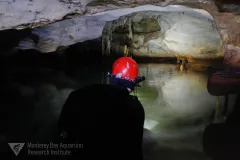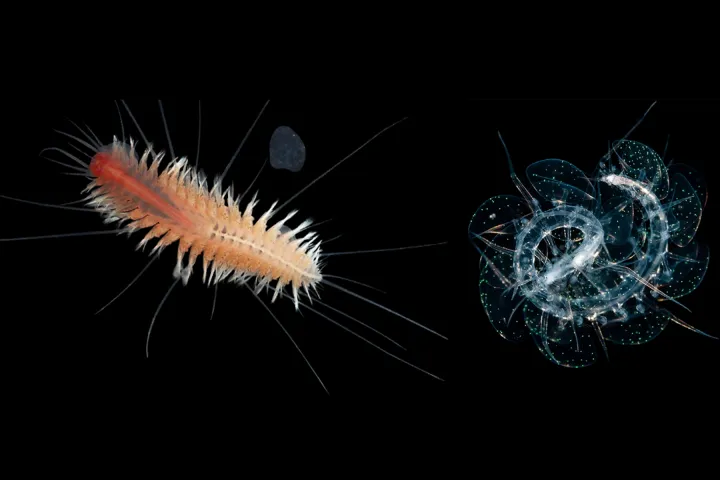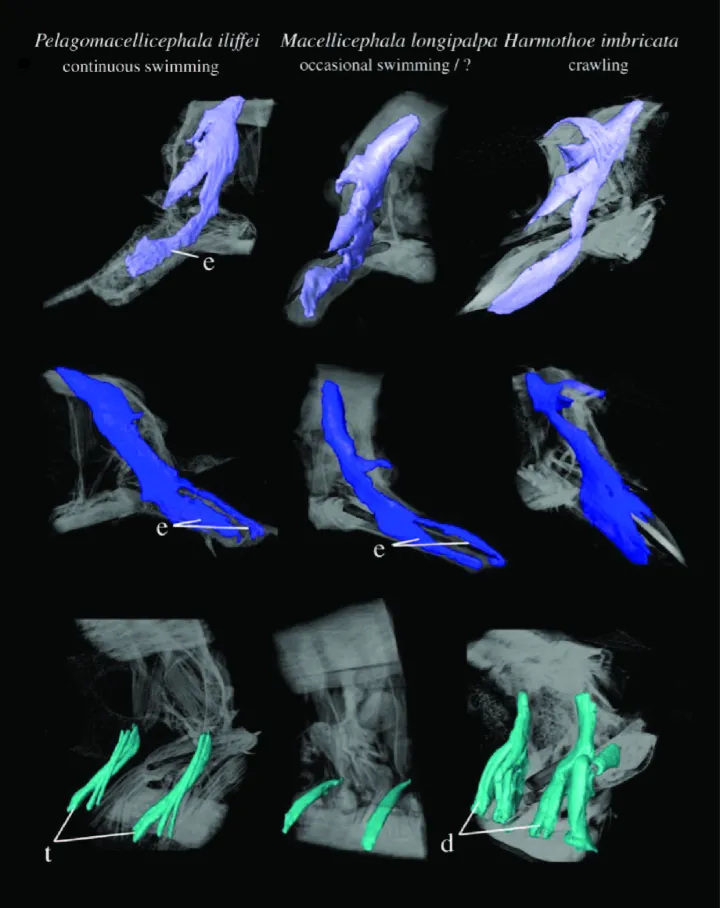Adaptation in the Extremes: What Scale Worms Teach Us About Evolution

Worms are known for loving dirt. This is true for land-lubbing earthworms as well as their cousins burrowed in the seafloor below thousands of meters of saltwater. But less popularly known are the many groups of marine segmented worms, or polychaetes, that make their homes in the water column. Without fins or flippers, these invertebrates have adapted their wormy appendages to fill that role and propel them through to water. Polychaetes pose an interesting case to learn about how life adapts to different environments.
Drs. Brett Gonzalez and Karen Osborn study evolution in extreme environments – places like the pitch-dark deep sea and isolated underwater caves. These environments are extreme by human definition, but for the marine segmented worms these researchers specialize in, millions of years of adaptation have made the challenges of these habitats commonplace.
Gonzalez’s research is focused on scale worms belonging to the family Polynoidae, a group of polychaetes (segmented worms) known for the overlapping scales typically covering their backs. These often vibrantly colored predators provide a perfect opportunity to study evolution.
“Scale worms burrow, build tubes, live in close association with other animals, or spend their entire lives swimming. They are found practically everywhere in the ocean, even in the most extreme environments, meaning they have adaptations at every level of the game,” notes Gonzalez, who works to understand the anatomical modifications that make scale worms the most successful and diverse group of marine segmented worms.
Not All Sea Creatures Swim
Swimming is a key adaptation that Osborn and Gonzalez examine. While swimming may seem like an essential ability for animals that live in water, scores of animals in the ocean don’t swim. Many ocean creatures live on the seafloor - crawling, burrowing or even permanently cemented to hard surfaces like corals and some annelid species. Most marine worms are benthic for their “adult” lives, meaning they live on the seafloor and either can’t lift themselves into the water column or aren’t able to maintain themselves there for more than the time it takes them to sink back down to the seafloor.
“Osborn continually returned from deep sea expeditions with scale worms she found in the water column, collected using remotely operated vehicles. We cave divers repeatedly saw scale worms swimming in the caves’ water columns too,” explains Gonzalez. “These worms were so far removed from their benthic relatives that I realized we’d been underestimating the ecological diversity of swimming scale worms for years.”
Scale worms are one group of polychaetes that have multiple continuously swimming or drifting species. By studying the differences between swimming and crawling species, researchers get to peek into the black box of evolution – recreating how different lineages have adapted to the challenges of life up in the water column.
“Our goal is to reconstruct the evolution of an animal group,” explains Osborn. “The evolutionary story for a behavior, such as swimming in annelids, typically arose in one of two ways - either swimming appeared once and was passed down through generations, or swimming evolved in multiple lineages independently. If the former, we expect similar genetics, behavior and anatomy in all descendents. But if swimming evolved multiple times, we expect the genetics, behavior and anatomy to be a bit different for each lineage given its different evolutionary history.
In the latter case, called convergent evolution, different branches in the scale worm family tree experienced environmental pressures that made swimming advantageous - perhaps escaping predators by swimming up into the water column allowed individuals in different lineages to survive long enough to make more offspring than their sluggish relatives, so swimming genes were passed on multiple times.
Mapping the Scale Worm Evolutionary Tree
To trace these evolutionary lineages, Gonzalez, Osborn, and colleagues at the University of Copenhagen analyzed the DNA of scale worms including three groups of swimming scale worms from extreme environments: the deep sea, the midwater, and submerged caves.
“There isn’t one gene that says ‘swim’ for annelids,” explains Gonzalez. “It’s a combination of genetic and developmental changes that creates the right body type for swimming.” The genetic analysis published in 2021 estimated that swimming evolved independently three times in the family Polynoidae.
This discovery was further supported when looking at the anatomy of the different groups. By comparing three swimming species (one deep-sea sporadic swimmer, one midwater drifter, and one subterranean cave drifter) with a crawling species, the research team was able to identify the anatomical swimming traits and look at the development of each in the different species.
Instead of re-inventing the wheel, these scale worms simply modified the muscles they had to be more appropriate for life up in the water column. Bulky, heavy muscles that require more energy to lift off the seafloor were reduced, muscles attached to the swimming appendages (parapodia) lengthened as the appendages lengthened into paddles. Each species accomplished these tasks with different muscle groups, but the outcome was the same— a lighter, more agile body that could move freely up in the water column.
For scale worms, a few changes to the right muscles enabled this group to exploit an even broader range of ocean habitats than other annelids. With an ocean that is still 95 percent unexplored, it is exciting to contemplate the potential discoveries and evolutionary puzzles waiting to be unraveled.



